The C10, Vermillion, and Red Lightning showings are associated with a trend of very strong Au BLEG anomalies (Figure 1). There have been numerous high-grade auriferous rock chip samples collected in this area. Rocks in the southern part of the Property exhibit greenschist metamorphism and a higher degree of deformation than rocks further north. This has the effect of overprinting hydrothermal alteration, ore mineralogy, and rock textures. This area may be transitional from the VMS mineralization seen to the north, and the likely porphyry mineralization seen to the south at the Ted Morris prospect.
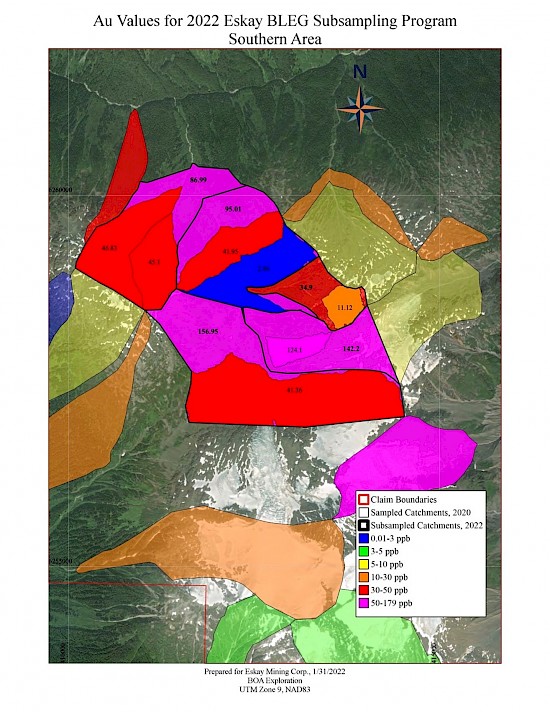
Figure 1: Results of the 2022 BLEG subsampling program of the C10-Vermillion area showing Au values. Sampling based on refined drainage catchments derived from Lidar data collected during 2020 confirms the trend of very strong Au anomalism discovered during the 2020 exploration program.
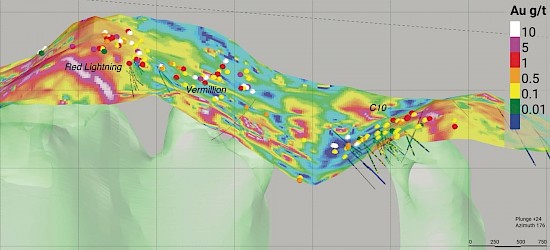
Figure 2: An oblique view of C10, Vermillion, and Red Lightning looking southwards. Each of these showings is associated with deep-seated magnetic susceptibility anomalies, as well as magnetic anomalies visible in the magnetic tilt derivative data draped on the surface. Gold assay results for rock chip samples (circles) are shown.
C10
Drilling at C10 followed up on auriferous drill core intercepts from the 2005-2006 drill programs (Figure 3), and tested several IP chargeability anomalies discovered during the 2020 exploration program.
Drill holes C21-1 through C21-4 tested the volume of rock surrounding drill hole CR05-17, and intercepted massive to peperitic andesite and dacite of the Betty Creek Formation. Peperitic rocks are characterized by flattened andesite or dacite fragments within a matrix of graphitic mudstone (Figure 4). Dacite is aphyric, however andesite commonly has plagioclase and hornblende phenocrysts. Incipient greenschist metamorphism is evident by the presence of ubiquitous chlorite, epidote, and quartz-carbonate veining. All of the rock intercepted by these drill holes is intensely foliated, and is broken to rubbly with faulted rock intercepted near the bottom.
Drill holes C21-5 through C21-7 targeted a trend of IP chargeability anomalies discovered during the 2020 exploration program. These drill holes intercepted thick intervals of Willow Ridge basalt underlain by Eskay rhyolite (Figure 5), both belonging to the Upper Hazelton Group. These rocks are weakly deformed, and do not show evidence of significant greenschist metamorphism. Stratigraphic up in C21-5 through C21-7 is up-hole and to the east, consistent with a position on the east limb of an antiformal structure, possibly a southern extension of the Eskay anticline.
The fault zone juxtaposing Lower Hazelton Group rocks of the northern block (intercepted by C21-1, C21-2, C21-3, and C21-4) with Upper Hazelton Group rocks of the southern block (intercepted by C21-5, C21-6, and C21-7) (Figures 6 and 7) is called the C10 fault. The surface trace of the C10 fault strikes 225 degrees with a vertical to subvertical dip. The C10 and nearby Vermillion faults are evident in the SkyTEM conductivity survey completed in 2021. Based on the sinistral strike-slip nature of the Vermillion fault ~1.5 km to the east (Figure 7), and a similar strike to the C10 fault, it is likely the C10 fault is also a sinistral strike-slip fault. The large amount of glacial sedimentary cover over much of the C10 fault zone inhibits determination of offset using currently available data.
Auriferous sulfide mineralization is restricted to Lower Hazelton Group rocks, and is characterized by foliation parallel bands of euhedral pyrite crystals ~1 mm in size, with the highest concentrations of pyrite found in peperitic dacite (Figure 4). Gold grade correlates with pyrite abundance. We interpret the foliation parallel pyrite at C10 to have undergone recrystallization during deformation and metamorphism. Based on the presence of similar aggregates of foliation parallel pyrite within zones of intense deformation at TV, and the same stratigraphic position of C10 with respect to TV (i.e., the Betty Creek Fm.).
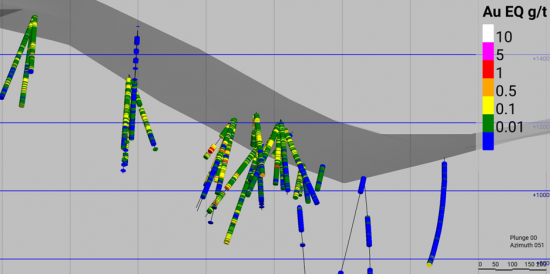
Figure 3: Assay results in Au equivalent (Au+Ag/78) for all drill holes at C10.

Figure 4: C21-4 showing representative examples of sulfide mineralization hosted by intensely sheared dacite breccia within a matrix of graphitic mudstone. Pyrite occurs as ~1 mm size euhedral grains in foliation parallel bands. The presence of dacite and graphite suggests this rock is peperitic, with VMS-derived sulfides recrystallized into foliation parallel bands of euhedral crystals. Drill core from the hanging wall of the C10 thrust fault is generally broken to faulted.
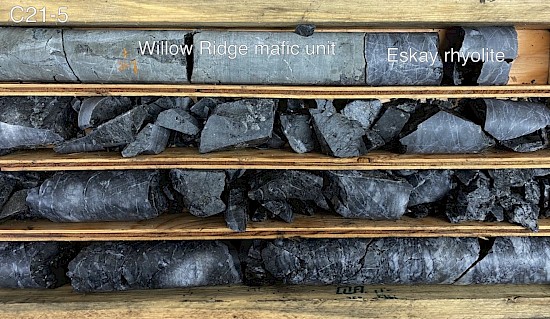
Figure 5: C21-5 drilled into the south block of the C10 fault, showing the contact between the Willow Ridge mafic unit and the Eskay rhyolite, both of the Upper Hazelton Group. The rhyolite is brecciated and mixed with carbonaceous mudstone in spots. All drill holes in the south block of the C10 fault intercepted Upper Hazelton Group rocks.
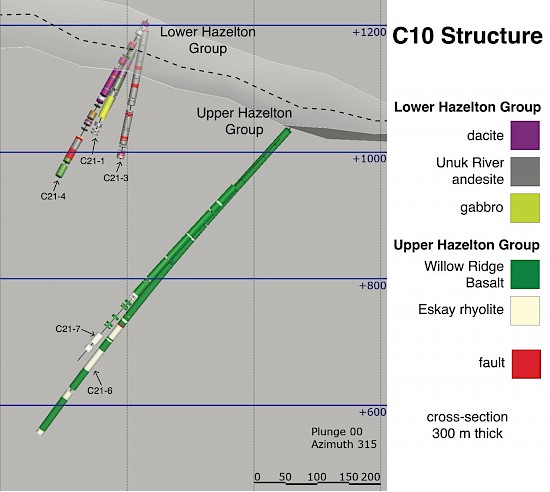
Figure 6: Cross-section looking along an azimuth of 315 degrees, showing Lower Hazelton Group rocks intercepted in the northern fault block juxtaposed against Upper Hazelton Group rocks in the southern fault block. The inferred fault denoted by the dashed line on the surface correlates with a sharp change in conductivity identified in the 2021 SkyTEM survey.

Figure 7: Conductivity map of the C10-Vermillion area showing the correlation between conductive features and the locations of the C10 and Vermillion faults. The Vermillion fault is a sinistral strike-slip fault, and has much better exposure than the C10 fault. The sinistral strike-slip interpretation of the C10 fault is based on the similar orientation with the Vermillion fault. The orientation and thickness the cross-section (A-A’) in Figure 9.11 is shown.
Vermillion
Vermillion lies on the east side of Mandy Valley, ~300 m west of the Red Lightning magmatic Ni-Cu showing, immediately south of a conductivity anomaly defining a sinistral strike-slip structure (Figures 2 and 7), and lies within a trend of very strong BLEG Au anomalies (Figure 1).
Field investigations found an outcrop of massive to semi-massive sulfide ~0.25 m thick and extending ~50 m along strike hosted by dacite (Figure 8). Rock samples (Figure 8) contain abundant pyrite, sphalerite, galena, and arsenopyrite. The host dacite is surrounded by intensely chloritized andesite, and both rock types are cut by diorite and gabbro dikes similar to those that host the Red Lightning showing. These lithologies are consistent with a stratigraphic position within the Betty Creek Formation.
Drill holes V21-1, V21-2, and V21-3 targeted the stratigraphy hosting the sulfide minerals found on the surface, and intercepted massive to peperitic andesite and dacite, volcaniclastic metasedimentary rocks, and gabbro dikes. All lithologies exhibit intense shearing and greenschist metamorphism. Sulfide mineralization on the surface and in drill core is associated with quartz-carbonate veins with accessory Mn-oxide and sulfosalt mineralization. The predominate sulfide minerals encountered in drill core are pyrite, sphalerite, and chalcopyrite (Figure 7).
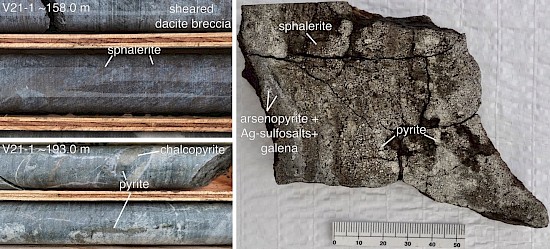
Figure 8: Sulfide minerals encountered in drill core and in outcrop at Vermillion. The predominate sulfide minerals in drill core are pyrite, sphalerite, and chalcopyrite. Rock chip sample V21-3 from outcrop contains abundant pyrite, sphalerite, galena, arsenopyrite, and Ag-sulfosalt minerals.
Red Lightning
Red Lightning is a gabbro-hosted magmatic Ni-Cu-Au-Pd deposit located ~300 m east of the massive sulfide outcrop at Vermillion (Figure 2). The gabbro hosting mineralization at Red Lightning was emplaced within Betty Creek Formation intermediate volcanic rocks. The host gabbro has zones of silicate-sulfide immiscibility with sulfide minerals grading from disseminated to massive textures (Figure 9). Sulfide mineralogy is dominated by pyrrhotite and chalcopyrite, with sphalerite and Ni-sulfides as accessory minerals. The gabbro displays distinct chilled margins at contacts with the Betty Creek Formation, and none where basaltic dikes cross-cut the gabbro, indicating the gabbro was emplaced after the intermediate volcanic rocks and before the cessation of basaltic volcanism. The resulting relative age of the gabbro places the intrusion during the period when VMS systems were active, suggesting the gabbro intrusion at Red Lightning may represent one of the rift-related magmatic intrusions that drove VMS hydrothermal systems in the area.
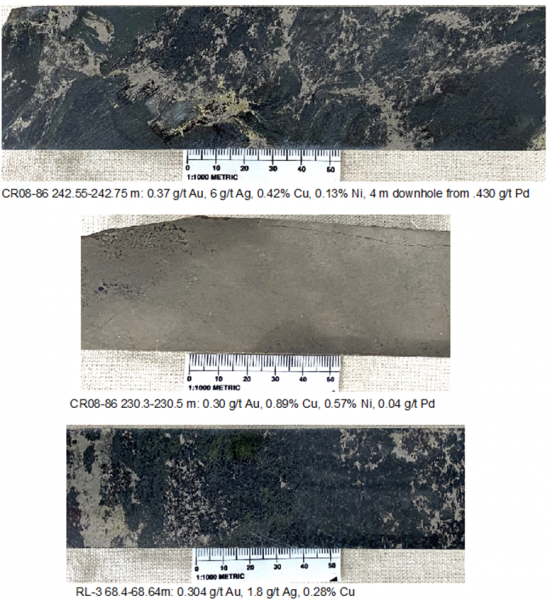
Figure 9: Representative core samples from Red Lightning. CR08-86 242.55-242.75 m is a chloritized and foliated gabbro with patches of clinopyroxene. Pyrrhotite and chalcopyrite infill the space between silicate minerals indicating sulfide-silicate immiscibility. CR08-86 230.3-230.5 m is massive pyrrhotite with blebs of chalcopyrite, and Ni-sulfide minerals. RL-3 exhibits sulfide-silicate immiscibility with the primary gabbroic texture well-preserved.
